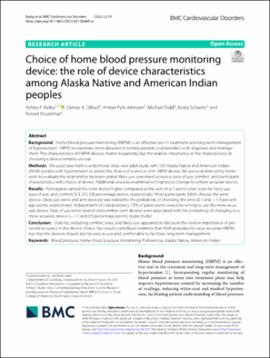| dc.contributor.author | Railey, Ashley F. | |
| dc.contributor.author | Dillard, Denise A. | |
| dc.contributor.author | Fyfe-Johnson, Amber | |
| dc.contributor.author | Todd, Michael | |
| dc.contributor.author | Schaefer, Krista | |
| dc.contributor.author | Rosenman, Robert | |
| dc.date.accessioned | 2022-11-07T14:34:15Z | |
| dc.date.available | 2022-11-07T14:34:15Z | |
| dc.date.issued | 2022-12 | |
| dc.identifier.citation | Railey, A.F., Dillard, D.A., Fyfe-Johnson, A., Todd, M., Schaefer, K., Rosenman, R. (2022). Choice of home blood pressure monitoring device: the role of device characteristics among Alaska Native and American Indian peoples. BMC Cardiovascular Disorders, 22(1), pp. 19-. https://doi.org/10.1186/s12872-021-02449-w | |
| dc.identifier.issn | 1471-2261 | |
| dc.identifier.uri | https://hdl.handle.net/11244/336604 | |
| dc.description.abstract | Background: Home blood pressure monitoring (HBPM) is an effective tool in treatment and long-term management of hypertension. HBPM incorporates more data points to help patients and providers with diagnosis and management. The characteristics of HBPM devices matter to patients, but the relative importance of the characteristics in choosing a device remains unclear. Methods: We used data from a randomized cross-over pilot study with 100 Alaska Native and American Indian (ANAI) people with hypertension to assess the choice of a wrist or arm HBPM device. We use a random utility framework to evaluate the relationship between stated likely use, perceived accuracy, ease of use, comfort, and participant characteristics with choice of device. Additional analyses examined willingness to change to a more accurate device. Results: Participants ranked the wrist device higher compared to the arm on a 5-point Likert scale for likely use, ease of use, and comfort (0.3, 0.5, 0.8 percentage points, respectively). Most participants (66%) choose the wrist device. Likely use (wrist and arm devices) was related to the probability of choosing the wrist (0.7 and − 1.4 percentage points, respectively). Independent of characteristics, 75% of participants would be willing to use the more accurate device. Ease of use (wrist device) and comfort (arm device) were associated with the probability of changing to a more accurate device (− 1.1 and 0.5 percentage points, respectively). Conclusion: Usability, including comfort, ease, and likely use, appeared to discount the relative importance of perceived accuracy in the device choice. Our results contribute evidence that ANAI populations value accurate HBPM, but that the devices should also be easy to use and comfortable to facilitate long-term management. | |
| dc.format | application/pdf | |
| dc.language | en_US | |
| dc.publisher | Springer Nature | |
| dc.relation.ispartof | BMC Cardiovascular Disorders, 22 (1) | |
| dc.relation.uri | http://dx.doi.org/10.1186/s12872-021-02449-w | |
| dc.rights | This material has been previously published. In the Oklahoma State University Library's institutional repository this version is made available through the open access principles and the terms of agreement/consent between the author(s) and the publisher. The permission policy on the use, reproduction or distribution of the material falls under fair use for educational, scholarship, and research purposes. Contact Digital Resources and Discovery Services at lib-dls@okstate.edu or 405-744-9161 for further information. | |
| dc.subject.mesh | American Indians or Alaska Natives | |
| dc.subject.mesh | Alaskan Natives | |
| dc.subject.mesh | Algorithms | |
| dc.subject.mesh | Blood Pressure | |
| dc.subject.mesh | Blood Pressure Monitoring, Ambulatory | |
| dc.subject.mesh | Cross-Over Studies | |
| dc.subject.mesh | Female | |
| dc.subject.mesh | Humans | |
| dc.subject.mesh | Hypertension | |
| dc.subject.mesh | Male | |
| dc.subject.mesh | Middle Aged | |
| dc.subject.mesh | Patient Compliance | |
| dc.subject.mesh | Pilot Projects | |
| dc.subject.mesh | Reproducibility of Results | |
| dc.subject.mesh | United States | |
| dc.subject.mesh | Humans | |
| dc.subject.mesh | Hypertension | |
| dc.subject.mesh | Blood Pressure Monitoring, Ambulatory | |
| dc.subject.mesh | Pilot Projects | |
| dc.subject.mesh | Cross-Over Studies | |
| dc.subject.mesh | Reproducibility of Results | |
| dc.subject.mesh | Patient Compliance | |
| dc.subject.mesh | Blood Pressure | |
| dc.subject.mesh | Algorithms | |
| dc.subject.mesh | Middle Aged | |
| dc.subject.mesh | United States | |
| dc.subject.mesh | Female | |
| dc.subject.mesh | Male | |
| dc.subject.mesh | Alaskan Natives | |
| dc.subject.mesh | American Indians or Alaska Natives | |
| dc.title | Choice of home blood pressure monitoring device: the role of device characteristics among Alaska Native and American Indian peoples | |
| dc.date.updated | 2022-11-03T21:14:43Z | |
| dc.note | open access status: Gold OA | |
| dc.identifier.doi | 10.1186/s12872-021-02449-w | |
| dc.description.department | Sociology | |
| dc.type.genre | Article | |
| dc.type.material | Text | |
| dc.subject.keywords | American Indian or Alaska Native | |
| dc.subject.keywords | Cardiovascular | |
| dc.subject.keywords | Detection, screening and diagnosis | |
| dc.subject.keywords | Evaluation of markers and technologies | |
| dc.subject.keywords | Cardiorespiratory Medicine and Haematology | |
| dc.subject.keywords | Cardiovascular System & Hematology | |
| dc.identifier.author | ORCID: 0000-0002-0763-5397 (Railey, Ashley F) | |
| dc.identifier.essn | 1471-2261 | |
